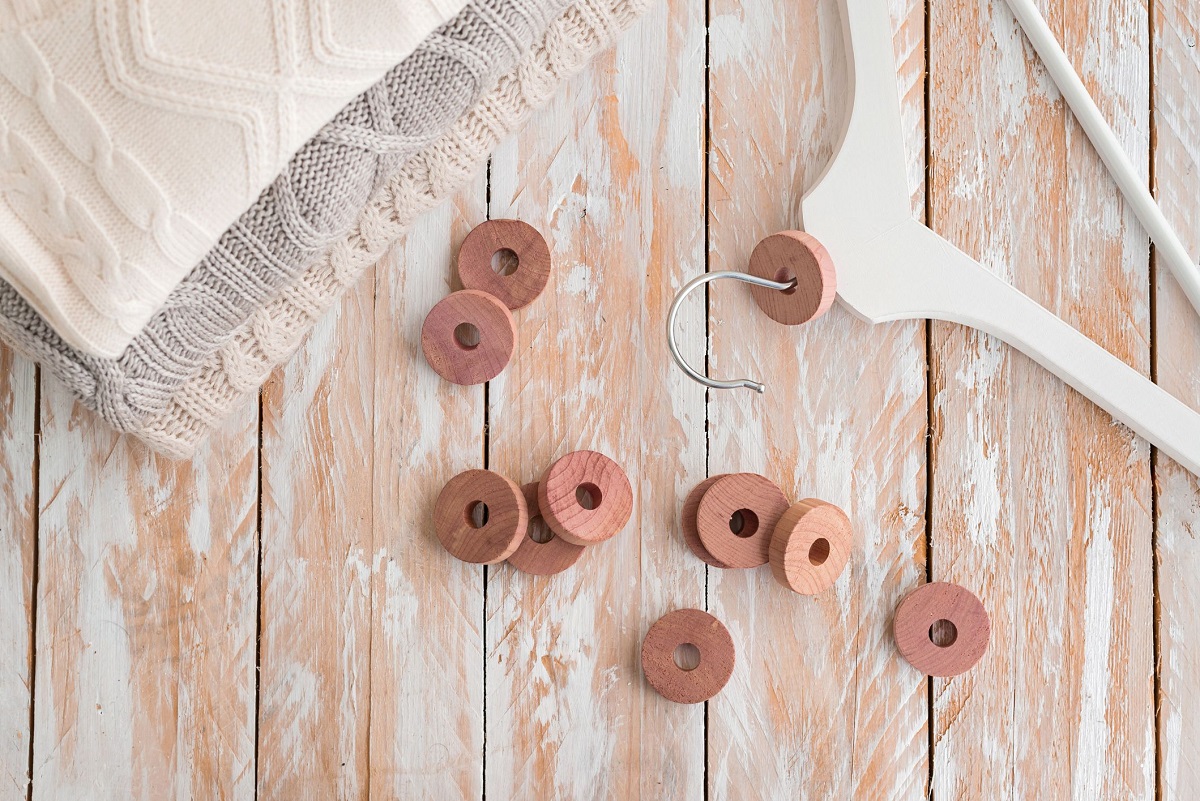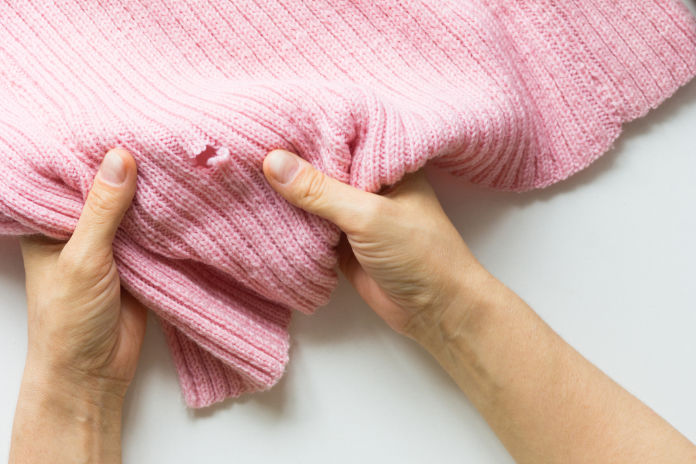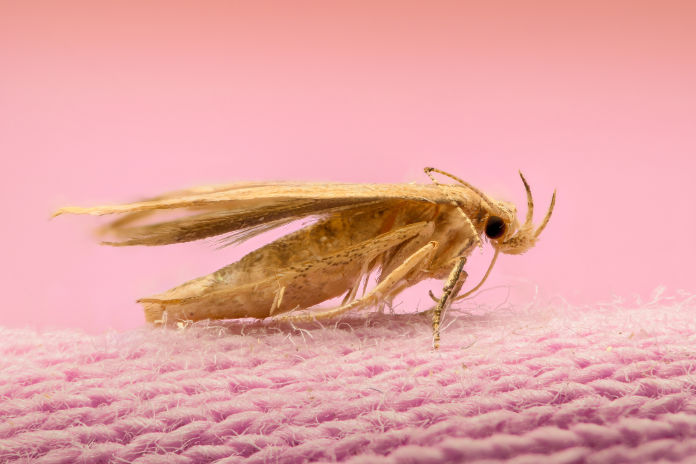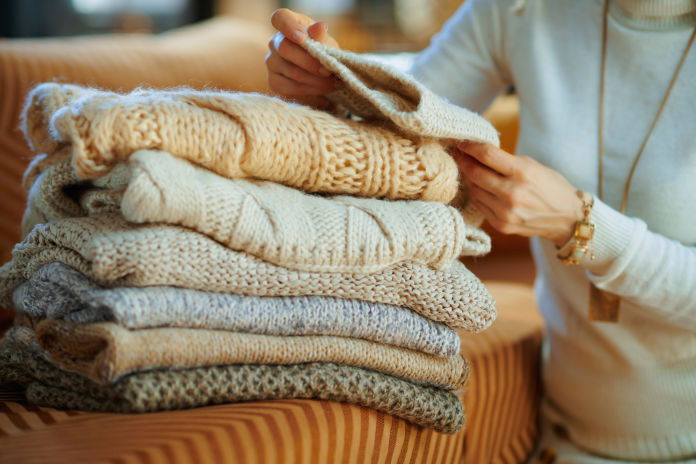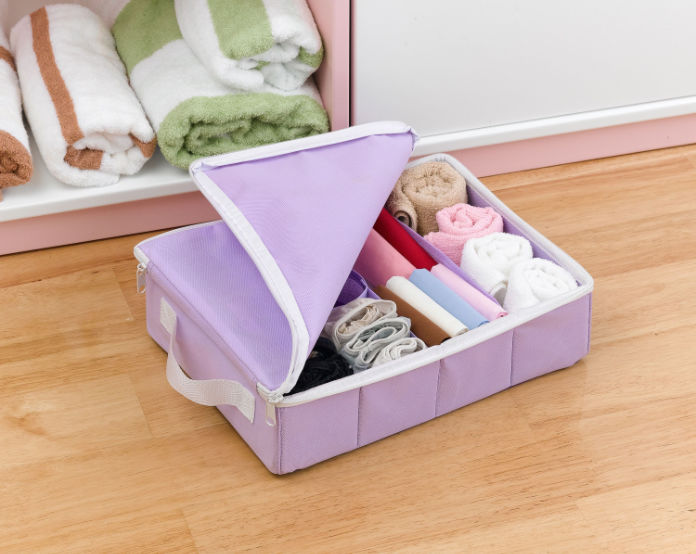They don’t buzz, they don’t bite and they’re harmless to humans – but for the common clothes moth, cashmere is king, wool carpets and silk throws are the holy grail. If you’re facing an infestation of these cloth-eating insects, read on to discover how to get rid of clothes moths.
Thanks to milder winters and warmer summers, we’ve been plagued by clothes moths in recent years. Enquiries to Rentokil rose more than 10% in 2019 compared to the previous summer, and 9% year on year over the previous three years. So more and more homes in the UK are under attack from these nibbling, nesting, nocturnal insects.
Moths tend to come out in warmer weather as it accelerates their breeding cycle, so we can expect the problem to only get worse. Our lifestyle is also a contributory factor according to Dr Chris Terrell-Nield, an entomologist at Nottingham Trent University.
Clothes moth damage is on the increase
“There are certainly more reports of clothes moth damage in recent years. This is largely due to our lifestyle. Centrally-heated homes provide year-round warmth throughout the house, which speeds up larval growth, producing more generations of adults. What we wear has also had an impact, since there is a trend towards more natural fibres and fashion clothing often being mass-produced; people often stockpile clothes. Moths also prefer dirty clothes (this adds to the nutritional quality) and love sweat residue. Stores often recommend dry-cleaning for natural fibres, so if people delay taking coats and suits to be cleaned, there is a ready egg-laying site, from which caterpillars can spread to other items,” he explains.
In the summer, it’s common to notice more moths indoors, but good news – they’re not all the garment-gorging kind.
“There are two basic categories: those that enter the house by accident and are unlikely to cause damage, and those that can breed inside houses, feeding on clothing and sometimes stored food. The former are more commonly seen in summer and autumn, the latter at any time of the year,” explains Dr Terrell-Nield. “You are likely to be visited by more of these ‘accidental’ moths in summer, because we often leave windows open at night, and most moths are attracted to light.”
Why do some homes attract more moths than others?
Where ‘accidentals’ are concerned, a number of factors apply here.
“This depends on how accessible the house is to night-flying insects,” says Dr Terrell-Nield. “It depends on where houses are, what kind of plants are in the garden and how biodiverse the local area is. Consequently, a city-centre flat is much less likely to attract lots of moths than a suburban house with a large garden, or one bordering semi-natural habitat, such as woodland.”
Talking of plants, these are actually key in your home’s moth-appeal.
“Moths are unfortunately attracted to certain plants, so if you’re growing them around your house, you may be the source of your own problem,” says gardening expert Andy Baxter. “Evening primroses, butterfly bushes, honeysuckles, foxglove, longer weeds and grass will all attract moths. Whether they’re growing outside, near your windows and doors, or if you’ve got some house-planted primroses, you could be attracting moths without even knowing it.”
Garment-gorging moths
Moths themselves don’t actually munch on fabrics – they nest in it. It’s their larvae that cause the damage.
Dr Chris Terrell-Nield says a few UK species can breed in houses, including “the brown house moth, the case-bearing clothes moth, and the common clothes moth”. The most commonly seen clothes moth is ‘tineola bisselliella’: Adult females are about 1cm-long, silvery brown, and can lay about 40 eggs. “These hatch in a few days, but the caterpillars can live for up to two years before becoming a chrysalis, from which the adult emerges,” Dr Terrell-Nield notes.
“The stage that causes damage is their caterpillar (larvae). Unusually for animals, these have the necessary enzymes to digest proteins such as keratin, which is what hair, wool and feathers are made of.
“When an animal dies outdoors in summer, after about a month, all that’s left is skin, hair and bones. The species found on this corpse include beetles (those that can eat your carpet) and clothes moths. So, as far as a clothes moth is concerned, your best woollen dress, cashmere sweater or sheepskin coat is a dead sheep, and thus a suitable place to lay its eggs!” he explains. “Locating a breeding site is helpful, as these moths are attracted to dark places such as wardrobes and draws, where clothes are usually stored. The larvae will eat any natural fibre, so curtains and bedding are equally at risk.”
Where do I find moths in the home?
The two most common moth species are the common clothes moth and case-bearing moth and they both shun the spotlight. They like hiding in the dark, folds of fabrics and off the beaten track where they’re unlikely to be disturbed. Think the attic, basement, storage cupboard and sock drawer that’s been idle all summer.
What fabrics are at risk from moths?
The common clothes larvae will leave random holes in natural fabrics such as woolly jumpers. The brown house larvae love to bed down and feed on wool, leather and feathers. The case-bearing clothes larvae make more regular holes in fabric, while the white-shouldered larvae are cited as causing the least damage to textiles.
Along with a penchant for wool, cottons, silks, cashmere and linens, moth larvae will worm their way into coats, hats, scarves, your nan’s vintage fur, down filled pillows, cushions and even soft toys, so keep a lid on the kids’ play box.
Tell-tale signs of a moth infestation
With a chill in the air, our first instinct is to reach for an extra layer of clothing and bedding and that’s when most of us are hit with a nasty surprise – holes in our clothes, blankets and throws.
How to prevent clothing moths
Dr Terrell-Nield says “the best solution is to make your house as unattractive as possible”. He suggests the following tips:
1. Turn off the heat and open windows in the daytime to allow air to circulate.
2. If you want windows open at night, draw the curtains and/or turn out lights. Use a fly screen at night and during the day too. This will prevent ‘accidentals’ entering, because once they’re in, a female clothes moth can lay between 40 and 50 eggs on your best threads – which can hatch within 10 days in mild weather.
3. Shake out your clothing in daylight once or twice a month. This will disturb/dislodge the insects and make you aware of any early stages or damage.
4. Beat rugs and cushions, then hang them out in the sun. Larvae don’t like light and will drop off.
5. Vacuum upholstery and fixed textiles regularly (especially under the bed and sofa) but put the bag or contents straight into an outside bin, since vacuuming itself tends not to kill eggs or larvae.
6. Use an environmentally-friendly household insecticide in hard-to-reach corners.
7. Clean clothes regularly – stained garments give the larvae more nutrients so the dirty laundry bin is their 24-hour room service. Wash suspect clothing at 50°C minimum. An economy low-temperature wash may not work. Alternatively, freeze items at -18°C for a couple of days.
8. Store rarely-worn clothing including cashmere and other natural fibres in a sealed bag. Moths can eat silk as well as hair-based fabrics, so wrap your best silk clothing in acid-free tissue and store in a breathable bag.
9. Declutter – each time you buy something, take an item to a charity shop or to be recycled.
10. Keep second-hand fabrics in sealed plastic bags until they’ve been thoroughly washed or dry-cleaned. Old furniture, clothes and upholstery can contain moths or their larvae – recognisable as inch-long, silvery threads.
11. Invest in moth repellents such as moth killer sprays which can be used on clothing and carpets; moth killer hangers which will kill the adult, larvae and eggs; moth glue traps which are very unsightly but these poison free cages will indicated there’s a problem; moth balls if you can stand the smell; and moth killer paper strips which can protect clothing for up to six months. You could also try cedarwood clothes moth rings on your hangers and lavender bags on your shelves to protect your clothes.
Instead of using naphthalene moth balls and cedar balls (which can be effective), why not try a Moth Box (totalwardrobecare.co.uk)? This contains a female pheromone and attracts male moths to its sticky interior.
12. If all else fails, call in a pest control company.
Employ some plant power
As well as being attracted to certain plants in and around your home, Andy Baxter says moths are repelled by certain plants too – which can be used in your anti-moth arsenal.
“Moths are repelled by certain types of plants, so your best defence is a natural one. Make life easier and get growing some lavender. The moth repellents you buy from shops often are largely lavender-based, so by growing it yourself, you’re saving a bit of cash and it’s natural too. For extra goodness, take the dried lavender and pop that in problem areas and you’re good to go,” Baxter suggests. “Spearmint is also a great one for achieving the same goal – moths just aren’t a fan of this and will avoid it. Take your spearmint and lavender and place it by windows, doors or any place where the moths are massing.”























































